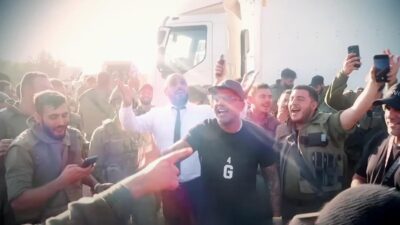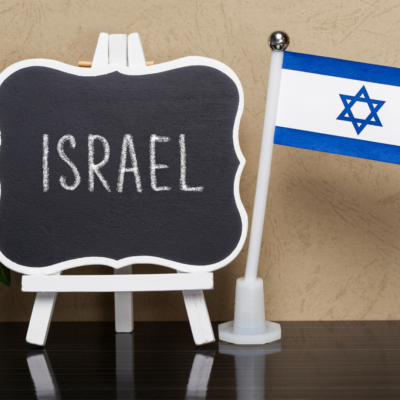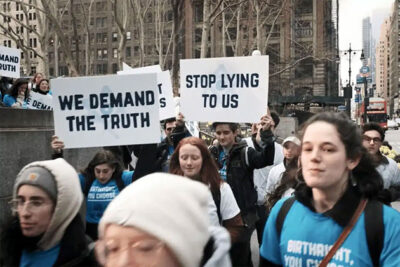Yom Yerushalayim (Jerusalem Day) has always felt different.
It’s been 18 years since my first celebration of Yom Yerushalayim — the anniversary of the liberation/conquering/reunification (depending on your perspective) of Jerusalem under Jewish sovereignty that took place during the Six-Day War — in Jerusalem.
My heart still yearns for Jerusalem, cares deeply about the Jewish capital and feels tremendous gratitude for Israel’s stunning victory in 1967.
And, at the same time, Yom Yerushalayim raises two questions for me which are more complicated:
- How does Yom Yerushalayim differ from the other three big “Yoms,” and why does it stand out as uniquely critical among the four, and yet is also the least celebrated in the Jewish world?
- Why does this day pose such a unique challenge within Israel itself?
Regardless of where you stand on these questions, I strongly encourage you to celebrate Yom Yerushalayim and explore the complexity of the day, this Sunday, May 29, with your students.
As the Yom commemoration and celebration fatigue sets in, there might be a temptation to let this holiday go by the wayside, but I urge you to take this day seriously and make this Yom Yerushalayim a memorable one with your students.
The momentous nature of the Six-Day War is difficult to overstate, so much so in fact, that Rabbi Ed Feinstein wrote, “For the first time, attachment to the State of Israel, as the most visible symbol of the Jewish will to survive, became the very heart of American Jewish identity.”
Use today’s Weekly article, and our film series, “The Six-Day War Project” and the accompanying educational resources, to help construct your educational experience.
As I often say, our goal is to help our students “feel the goosebumps and explore the complexity.” Here’s what I mean by this for Yom Yerushalayim:
Let’s feel the goosebumps over Israel’s miraculous victory in 1967 and help our students understand what that moment was like for Israelis and World Jewry.
And, let’s also explore the ways in which Yom Yerushalayim is complicated within Israel, and how Israel’s victory 55 years ago created many difficult challenges the Jewish state still faces today.
How can we do this in the classroom? Our editor Sara Himeles compiled eight ways from Unpacked for Educators to frame Yom Yerushalayim for yourself and with your students to help feel the goosebumps and explore the complexity of the day.
Best,
Noam
How to engage your students in the themes of Yom Yerushalayim:
1. Learn the history of the Six-Day War with your students.
Use our film, “The Six-Day War Project” to give your students an overview of what happened on each day of the war, including a play-by-play of Israel’s strategy, leadership and impressive military feats. You can also share this article on the history of the war with your students.
Through the film, students will understand the road leading up to the war, how Israel prepared for a total catastrophe, the euphoric nature of Israel’s victory and new concerns the war raised for Israel.
Then, use the accompanying prompts to engage your students in important questions and issues that Israel faced in the aftermath of the war and still does to this day.
2. Explore the Six-Day War through Israeli and Palestinian/Arab narratives.
As we wrote about last week following the death of Al Jazeera reporter Shireen Abu Akleh, the facts of what happened matter and narratives matter.
For Israeli Jews and many Jews around the world, Israel’s victory in the Six-Day War meant the miraculous liberation and reunification of Jerusalem after thousands of years. This is a day full of jubilation, a step forward towards redemption.
For Palestinians and the Arab world, it meant that the Israeli enemy had conquered Jerusalem, the site of the Al-Aqsa Mosque which is Islam’s third-holiest shrine. This is called the Naksa, meaning “the setback” in Arabic (not to be confused with the Nakba, which is the term for “catastrophe” referring to 1948).
Ask your students to read these dual narratives of the Six-Day War from Prime (the Peace Research Institute in the Middle East) (see chapter 3 starting on p. 37 of the packet).
After reading the narratives, ask them to put themselves in the shoes of a Jewish teenager living in Israel or an Arab teenager living in one of the neighboring countries or in the West Bank (which was then under Jordanian control), and journal their reaction to the following statement by Egyptian President Gamal Abdel Nasser the day before the war:
“The armies of Egypt, Jordan, Syria and Lebanon are poised on the borders of Israel…to face the challenge, while standing behind us are the armies of Iraq, Algeria, Kuwait, Sudan and the whole Arab nation. This act will astound the world. Today they will know that the Arabs were arranged for battle; the crucial hour has arrived. We have reached the stage of serious action and not declaration.”
3. Help your students understand how the settlements came to be.
During the six days of the war, Israel had tripled its size and gained control of the Eastern Jerusalem, the West Bank and the Gaza Strip (as well as the Sinai Peninsula and Golan Heights). But the Six-Day War was a victory that came with a lot of complications.
After the war, many Israelis were moved to settle in the newly-acquired lands (or newly “occupied” lands, depending on your point of view), which they viewed as vital to Israel’s security, as being won in a defensive war, and part of the Jewish people’s ancient homeland.
However, for the Palestinian Arabs living there, “the whole land of Palestine was occupied,” the Palestinian politician Samiha Khalil wrote. Use this video and the accompanying prompts to engage your students in how the settlements came to be.
4. Explore the challenges and impact of Israel’s victory in the war.
In 1976, the controversial public intellectual Yeshayahu Leibowitz wrote the following about the impacts of the war:
“In a world from which colonialism has been eliminated, Israel, since 1967, is endeavoring to impose colonial rule on the territory of a foreign people. Two aspects of Israeli rule over the West Bank and Gaza ought to be considered…
The question of the internal implications of including one and a quarter million Arabs of the West Bank and Gaza under the rule of the State of Israel…
The second problem involves the implications for Jewish-Arab relations. The occupation rule in the West Bank and Gaza will bring about solidarity of the half a million Israeli Arab citizens with their brothers in the occupied territories.
This will lead to a radical change in their state of mind. Inevitably, they will no longer regard themselves as citizens of the State of Israel, but rather as members of a people exploited by a state.”
Ask your students to respond to Leibowitz’s quote: Do you agree with Leibowitz’s assessment of the impact of the war? How would you respond to Leibowitz? Looking back at this in 2022, do you think he was prescient in his prediction of what would unfold, or do you see his perspective as misguided?
5. Debate Moshe Dayan’s decision to relinquish control of the Temple Mount.
The pinnacle of the Six-Day War was Israeli Colonel Motta Gur’s famous declaration on the radio: “Har Habayit biyadeinu,” “The Temple Mount is in our hands!” For the first time in 2,000 years, the Jewish people’s holiest site was now under Jewish control.
A few moments later, the Israeli flag was fastened to the top of the Dome of the Rock, but this excitement was immediately toned down when Defense Minister Moshe Dayan essentially said, “Are you crazy? You are going to bring the entire Middle East into a war!”
So, the Israeli flag was removed, and something wilder happened next. Just at the moment that the Jewish people had reconnected with their holiest site, Dayan struck a deal with the Jordanian Muslim Waqf, who had been in control of the site.
In this deal, Jews could finally visit the Temple Mount and the Western Wall, to which they had been denied access for centuries. Officially, the Temple Mount would be under Israeli sovereignty and security.
But in an effort to bring down the hostility and minimize the conflict, Israel relinquished governance of the site to the Waqf and allowed them to decide who could pray there and who could not.
“We did not come to conquer the sacred sites of others or to restrict their religious rights, but rather to ensure the integrity of the city and to live in it with others in fraternity,” Dayan said at the time of his decision.
Since this moment more than 50 years ago, in what is known as the status quo agreement, Jews have been allowed to visit but not pray at the Temple Mount.
Israelis still vehemently argue over whether Dayan made the right decision and whether it was an act of wisdom or weakness. Invite your students to join the debate:
Ask them to read this article about the Temple Mount and Dayan’s fateful decision. Then, ask them to respond to the following questions: Do you agree with Dayan’s reasoning and decision? Would you have set the same policy or a different one?
6. Invite students to reflect on what Jerusalem means to them.
Yom Yerushalayim is an opportunity to explore the history, geography and/or symbolism of Jerusalem with your students, and how it is central to Jewish thought and tradition.
To explore the Jewish connection to Jerusalem and the West Bank, use our video on the topic and the accompanying educational resources. You can also lead your students in an experiential learning activity on the related theme of “home.”
Plan ahead: Before class, ask each student to bring a picture that represents what Jerusalem means to him or her. Display the picture on the board or pass it around and have the student explain his or her choice.
You can also place all of the images in the center of the room and ask each student to choose a different image (not the one that they brought) and explain what it means to them.
7. Explore why Yom Yerushalayim is complicated in Israel today.
On the one hand, Rabbi Avi Berman, executive director of the Israeli branch of the Orthodox Union, described the significance of the day this way:
“[The Jewish people have] the ability to just walk over to the Kotel, to walk around Jerusalem… This is the land that David Hamelech was walking around in, Shlomo Hamelech, all the Jewish kings — this is where everybody aspired to be. And thank God, we’re able to walk around here like no other generation before us.”
Similarly, Rabbi Ethan Tucker, Rosh Yeshiva at Mechon Hadar, wrote of the day: “An age-old dream of the Jewish people has been realized…We can now freely walk in the pathways of our ancestors and connect with the land that was the cradle of our civilization.”
On the other hand, each year on Jerusalem Day, Religious Zionist Jews march through the Muslim Quarter in Jerusalem, which many Palestinians view as an act of provocation. However, the route has been changed in recent years when the security situation required it.
Last year, Israeli authorities altered the route of the march to avoid passing through the Damascus Gate and the Muslim Quarter, following Hamas threats and heightened tensions on the Temple Mount.
Despite this, Hamas fired rockets at Jerusalem while the march was in progress, sparking an 11-day war.
Last week, Israeli Public Security Minister Omer Barlev announced that this year’s march will be allowed to pass through the Muslim Quarter. In response, the organizers of the march praised Barlev’s decision, saying in a statement:
“There is nothing better than marching through all of the city during Jerusalem’s holiday. The traditional ‘flag dance’ represents…the liberation of Jerusalem and its connection from west to east, through tens of thousands of people marching happily through the streets of the Old City, on their way to the Western Wall.”
However, Arab-Israeli Regional Cooperation Minister Esawi Frej disagreed with the decision, tweeting in Hebrew:
“The decision to approve the route of the provocation march through the Muslim Quarter and Damascus Gate is a dangerous and concerning mistake. The purpose of holding the march in the heart of East Jerusalem is not the betterment of Jerusalem, but the desire to set it aflame, which is why I intend to take action to change the decision in order to prevent its dangerous ramifications.”
ההחלטה לאשר את מעבר צעדת הפרובוקציה ברובע המוסלמי ובשער שכם, היא טעות מסוכנת ומדאיגה.
— 🟣 Esawi Frej عيساوي فريج עיסאווי פריג (@EsawiFr) May 18, 2022
מטרת הצעדה בלב מזרח ירושלים, איננה טובת ירושלים, אלא הרצון להבעירה, לכן בכוונתי לפעול לשינוי ההחלטה, כדי למנוע את השלכותיה המסוכנות.
“Channel 13 news reported that Foreign Minister Yair Lapid and Defense Minister Benny Gantz both expressed reservations, but not outright opposition, regarding the Damascus Gate route,” The Times of Israel reported.
Ask your students if they think the march should be allowed to proceed through the Damascus Gate. What are the reasons the march should go through the Muslim Quarter and what are reasons to oppose it? What should Israel’s policy be this year?
8. Listen to these songs about Jerusalem with your students.
To help your students “feel the goosebumps” on this day, listen to one of the following songs about Jerusalem, and follow along with the lyrics and English translation.
Whether these songs transport your students to the “Yerushalayim shel ma’alah” (heavenly Jerusalem) that we hope it will one day become, or the complexity of “Yerushalayim shel matah” (earthly Jerusalem) as it exists today, they will help convey the beauty of Jerusalem and the spirit of the day.
Omer Adam, “Yerushalayim” (Jerusalem) (lyrics)
Meir Ariel, “Yerushalayim Shel Barzel” (Jerusalem of Iron) (lyrics and background)
Ofra Haza, “Yerushalayim Shel Zahav” (Jerusalem of Gold) (written by Naomi Shemer) (lyrics)
Noey Jacobson, “Yerushalayim Shel Zahav” (Jerusalem of Gold) (lyrics)
Yaakov Shwekey, “Im Eshkachech” (“If I forget you”) (Tehillim/Psalms 137: 5-6)





